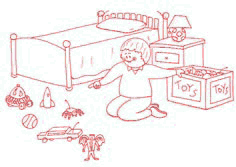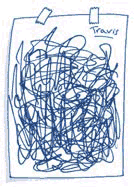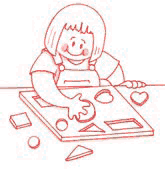|
Learning Activities for Toddlers
What to expect:
Between their first and second birthdays, children

- Are self-centered;
- Are energetic, busy and curious;
- Want to be independent and to do things for themselves;
- Play alone or alongside other toddlers;
- Have short attention spans if they are not involved in an activity that interests them;
- Begin to see how they are like and unlike other children;
- Like to imitate the sounds and actions of others (for example, by repeating words that parents and others say and by pretending to do housework or yard work with adults);
- Increase their spoken vocabularies from about 2 or 3 words to about 250 words and understand more of what people say to them;
- Ask parents and others to read aloud to them, often requesting favorite books or stories; and
- Pretend to read and write the way they see parents and others do.
- Add variations to their physical skills (for example, by walking backwards);
Between their second and third birthdays, children

- Begin to count;
- Become more aware of others;
- Able to walk, run, jump, hop, roll and climb;
- Become more aware of their own feelings and thoughts;
- Are often stubborn and may have temper tantrums;
- Put together 2-, 3- and 4-word spoken sentences;
- Begin to choose favorite stories and books to hear read aloud;
- Begin to pay attention to print, such as the letters in their names;
- Begin to distinguish between drawing and writing; and
- Begin to scribble, making some marks that are like letters.
- Expand their spoken vocabularies from about 250 to 1,000 words during the year;
What Toddlers Need
1- to 2-year-old children require

- Opportunities to make their own choices:
"Do you want the red cup or the blue one?";
- Clear and reasonable limits;
- Opportunities to use large muscles in the arms and legs;
- Opportunities to use small muscles to manipulate small objects, such as puzzles and stackable toys;
- Activities that allow them to touch, taste, smell, hear and see new things;
- Chances to learn about "cause and effect" - that things they do cause other things to happen (for example, stacking blocks too high will cause the blocks to fall);
- Opportunities to develop and practice their language skills;
- Opportunities to play with and learn about alphabet letters and numbers; and
- Opportunities to learn about books and print.
2- to 3-year-old children require opportunities to
- Develop hand coordination (for example, by holding crayons and pencils, putting together puzzles or stringing large beads);
- Do more things for themselves, such as dressing themselves;
- Talk, sing and develop their language skills;
- Play with other children and develop their social skills;
- Try out different ways to move their bodies;
- Learn more about printed language and books and how they work;
- Do things to build vocabulary and knowledge and to learn more about the world, such as taking walks and visiting libraries, museums, restaurants, parks and zoos.
Children need to hear a lot of words in order to learn howto communicate. It's particularly helpful when you talk
about the "here and now" - things that are going on in front of your child. |
Learning Activities for Children:
|
|
|